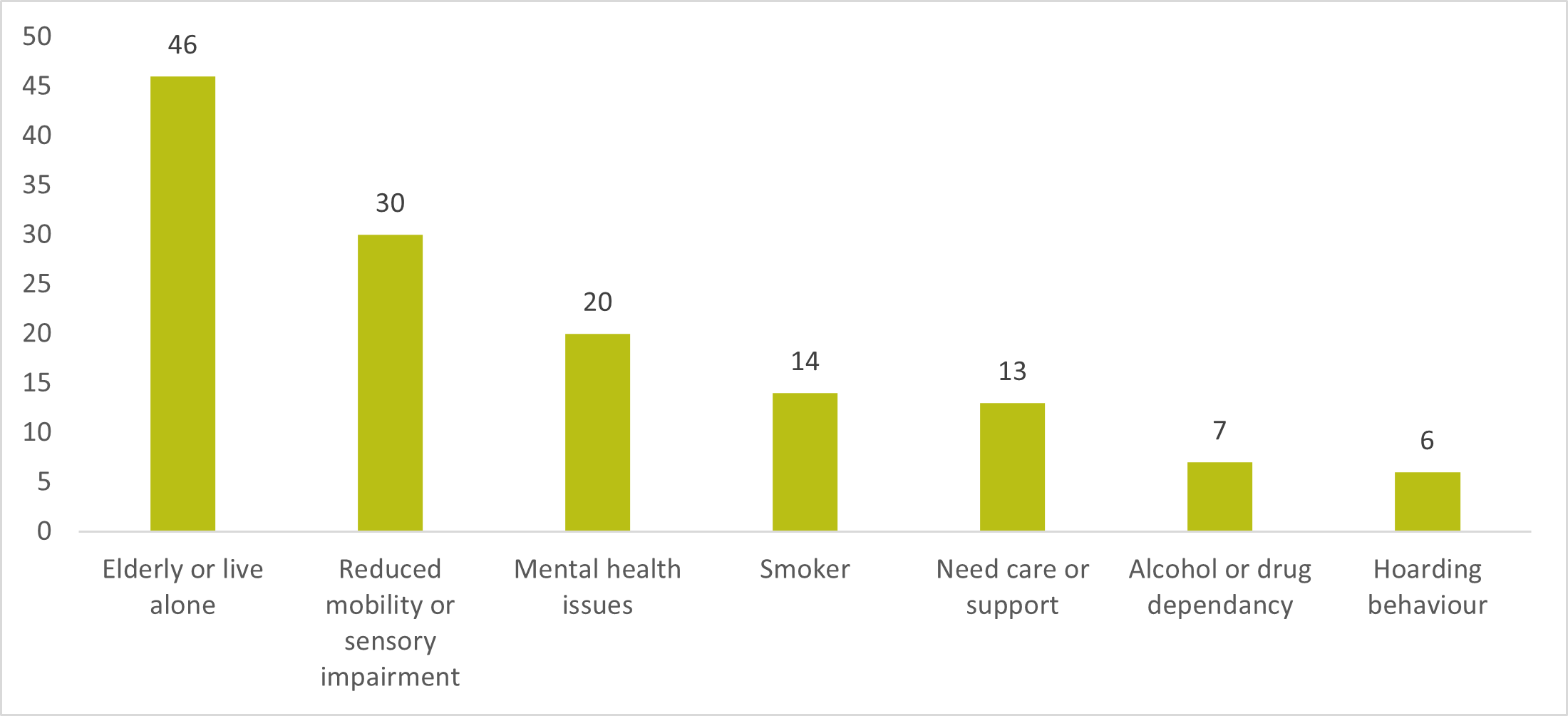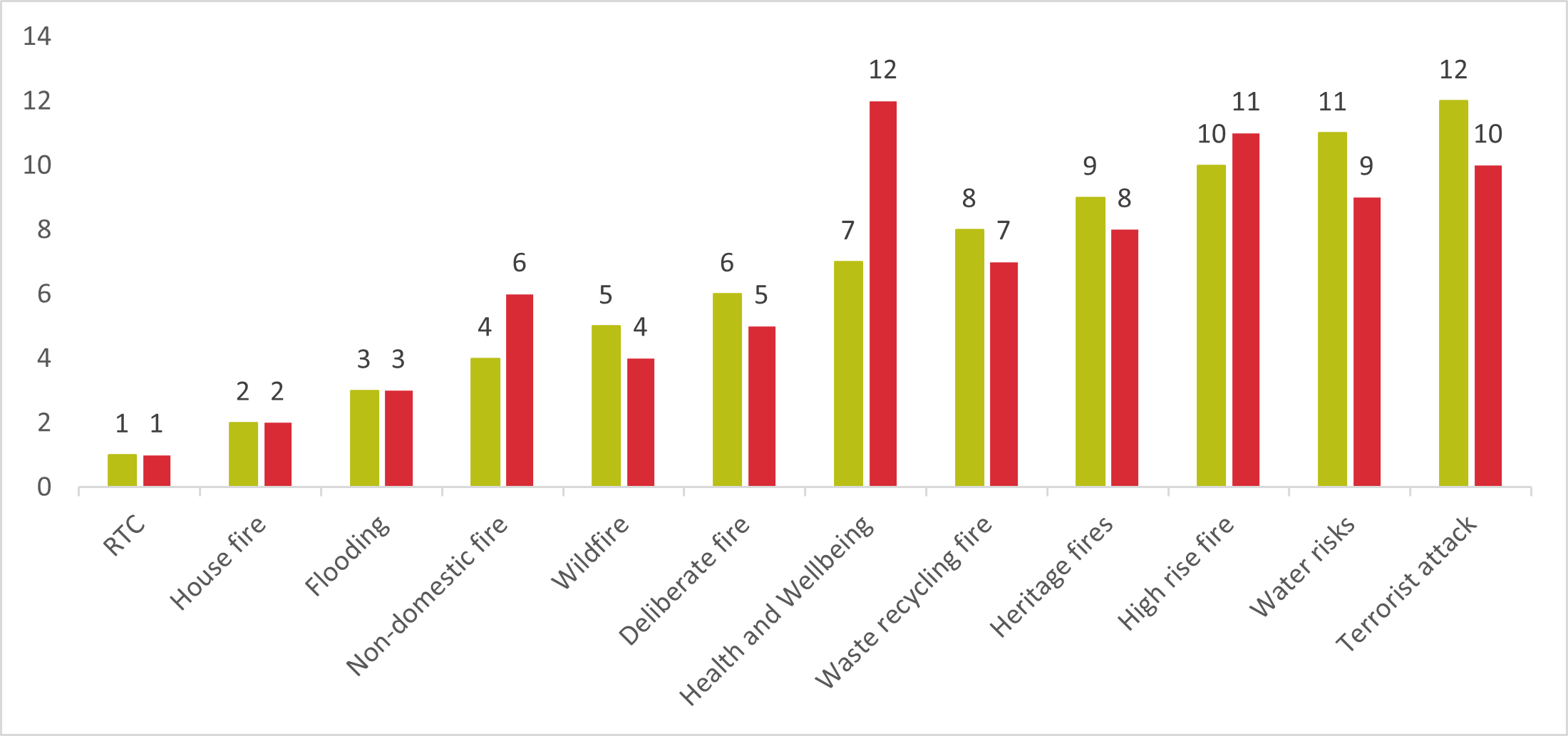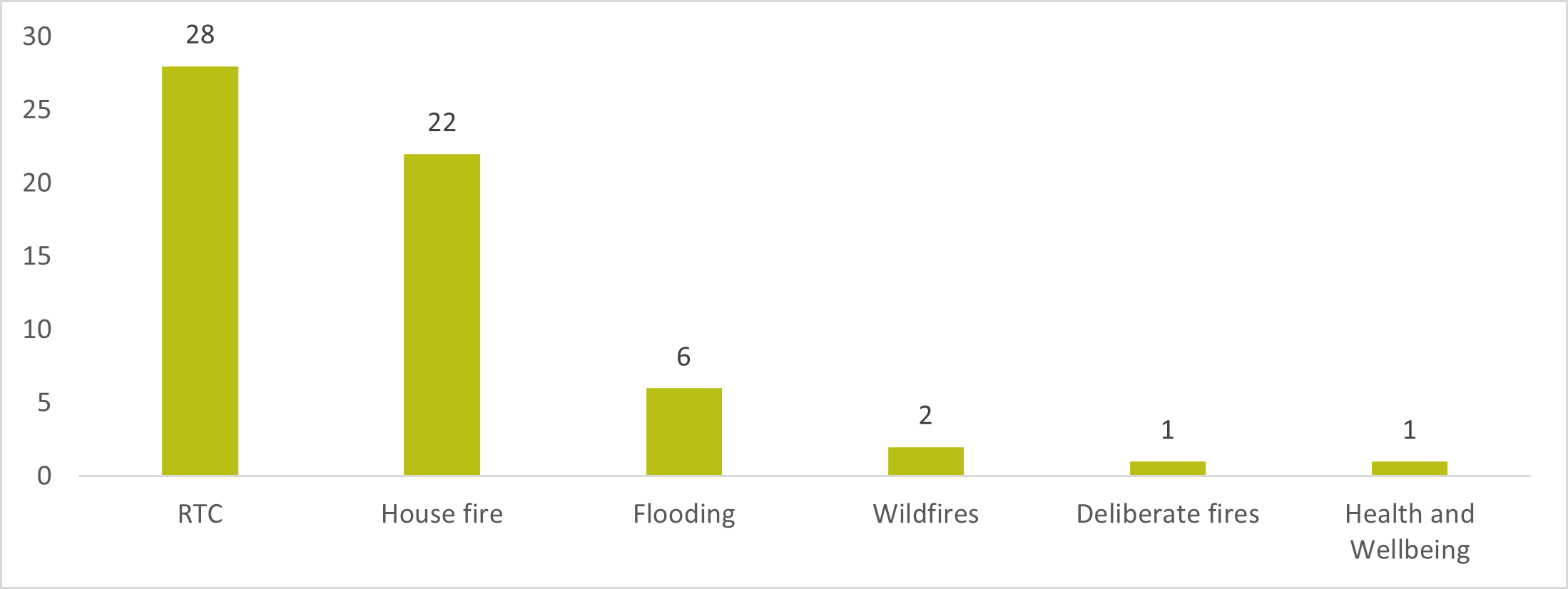Overview
Executive summary
This report summarises 2024’s Community Risk Management Plan (CRMP) engagement findings. This was a lower profile activity than the first or final stage to avoid process fatigue. Promotion was less wide-spread and more targeted.
The survey and poll results show that the top issues are:
- Road Traffic Collision
- Dwelling (house) fire
- Flooding
- Non-domestic fire
- Wildfire
- Deliberate fire (arson)
Efforts were made once again to reach a broad Lincolnshire audience. While not entirely successful in getting a proportionate response from all seldom heard groups, there were responses from all geographies and SHERMAN representatives.
Importantly, further learning was gained that will be applied in the final, consultation stage later in the year. Recommendations include face-to-face targeting of young people and those identifying as being from an ethnic minority.
Introduction
Fire and Rescue services across England must, by law, produce a Community Risk Management Plan (CRMP) on a four-yearly cycle (previously known as an integrated risk management plan). The process to produce the plan must include public and professional stakeholders and the approach taken is open to His Majesty’s Inspectorate scrutiny, as well as local scrutiny and approval.
The service is part way through a three-stage process of engagement. The first pre-engagement stage happened in autumn 2022 to ‘test’ knowledge, awareness and risk identification. The second stage happened through spring 2023. The key objectives of stage 2 were to:
- ascertain public views on proposed risk levels
- continue improved response, but with low key promotion to avoid survey fatigue
- further target ‘seldom heard communities’, reached and missing from stage 1 and updated EqIA, representative of the new census data
- have translatable content on demand (to highly prevalent other languages in Lincolnshire)
- use incentives for survey responses (entered into draw to win £20 voucher)
- use remote face-to-face input using tablets or other technology
- incorporate Let’s talk Lincolnshire as a platform
- make responses quick and easy to complete, using a poll in addition to a survey
- advertise using multiple internal or external platforms, but primarily target previous respondents and underrepresented groups from stage 1
Stakeholders
Using Lincolnshire County Council (LCC) databases, online research and existing network contacts the following were targetted:
- members of the public – news release on LCC website, social media, direct email invite
- one online news release, weekly socials posts in LCC and Lincolnshire Fire and Rescue (LFR), two targeted emails to members of the engagement database and stage 1 participants who wanted to remain informed (almost one quarter of all respondents)
- individuals, groups and organisations who can reach out to members of the public – direct email containing a newsletter article to share with their networks
- targeted messages (launch) to around 1000 people
- Fire and Rescue use the SHERMAN vulnerability approach, all of whom were included in the EqIA – email to representative individuals and groups
- the most common SHERMAN characteristics identified related to age (46 elderly or live alone, 30 reduced mobility or sensory impairments and 14 need care or support) and mental health issues (20). The graph below shows response numbers from people with SHERMAN characteristics

Just over 95% of respondents who answered the question about ethnicity described themselves as White British. This is slightly higher than stage 1 (93%). Half of all responses from people with other ethnic backgrounds had mixed heritage. This was about 2.5% of all responses.
Methodology
An online survey was the primary means of engagement during stage 2, with the addition of a poll to make it easier for people to respond in one click. All elements are translatable into many languages and work with read out technology for example. It was promoted widely on social media and a news release featured on the LCC home page. Previous respondents and those who had registered an interest in community safety received a direct email. It was consciously done in a more low-key manner than stage 1 or 3, to avoid CRMP or survey fatigue.
It was available on request in different formats for those without digital access and those for whom English wasn’t a first language for example. The single equalities council were targeted as part of equality impact assessment action planning, but the organisation was in the process of migration at the time. They will be engaged further for the final stage consultation. More information was sent directly to colleges, universities and local religious organisations in the hope of extending reach and interest. The final stage will avoid religious holidays such as Ramadan and Easter, making it easier for people to participate.
In response to a mid-point review, the survey and poll were left open for longer than originally planned to allow young people and people of all backgrounds to be targeted face-to-face at upcoming events. The same methodology of targeted face to face engagement will be applied at key events in stage 3.
Finding and conclusions
Survey
There were 169 responses to the survey from 164 contributors at the end of April 2023. This is fewer than the first stage (as expected), but more than the previous IRMP received at any stage.
When considering the priority order and importance of each risk, there are some variations, depending on how it is calculated. Taking the most voted risk places health and wellbeing as the bottom priority (red column in chart below). Taking a more robust cumulative score across all priorities places it seventh (green column in chart below). The top three remain the same.
The fairest way to calculate priority is to look at the total score across all 12 ranking positions (multiplying the number of people who voted by the priority score and adding them all together). This also more accurately reflects the poll result.

- more than half of all respondents ranked road traffic collisions (RTCs) as their most important risk (86, 51%). Over nine in ten had this risk in their top three (154, 91%)
- four in ten respondents ranked dwelling fires as their second most important risk (68, 40%). Almost eight in ten had this risk in their top three (130, 77%)
- three in ten respondents ranked flooding as their third most important risk (51, 30%). More than four in ten had this risk in their top three (72, 43%)
- flooding remained the most frequently voted fourth most important risk (27) and wildfires were the most frequently voted for fifth most important risk (30)
- a terrorist attack was the most voted for lowest priority risk (46, 27%)
- the overall order is slightly different to the number of votes received in stage 1
Reasoning
Thirty-five respondents added further comments, the most common were:
- a difficult choice to establish priorities (7)
- risk to or preservation of life must be prioritised (5)
- climate and environmental concerns, primarily in relation to flooding risk (5)
Other remarks included:
- many of the non-statutory services can be delivered by, or with, other agencies (4)
- prioritise tackling fires (3 plus1 specific to dwelling fires)
- ranked based on the likelihood of them affecting me or the community (3)
Most comments were neutral (75%), 15% mixed and 10% negative. The negative remarks related to ranking being too complicated (2), a lack of action on flooding (1) and highways issues (1).
Findings by characteristic
There was little difference between the general population’s view and those with protected or SHERMAN characteristics:
- people describing themselves as having reduced mobility or physical or sensory impairment mirrored the general responding population entirely
- those with a drug or alcohol dependency ranked domestic fires slightly higher than RTCs
- smokers had the same top three as the general population, but with very little between domestic fires and RTCs, but a much larger gap between them and flooding
- respondents with mental health issues ranked domestic fires and RTCs in the same way as the general population, but water risks were ranked much more highly than other cohorts
- people from non-White British backgrounds had the same top two as the general population, but deliberate fires or arson, which was a slightly different list to that in phase 1. This is a limitation of looking at small numbers and a further reason to ensure engagement with minority ethnic groups continues to be a focus
- there was little geographic difference in risk priority. North Kesteven (31 respondents) was the only district that ranked dwelling fires above RTCs (one point margin)
- the 33 respondents living in Lincoln top three issues matched the broader population, but seven people also included high rise fires in their top 3. This is likely a result of the concentration of this type of building in the city, compared to other parts of the county
Poll
Only six categories received a vote in the quick poll. They were spread mainly across RTCs and house fires, which reflects the survey, with flooding coming in third. The other three categories shared just four votes.

Conclusions and next steps
The findings of this survey are self-explanatory. It is recommended that what the public has said is considered when looking at operational statistics and resource impact while preparing the CRMP document for consultation.
Keep the poll open to the public until after the early May bank holidays. This will allow QR code use to continue as part of general engagement at high-footfall events.
The EqIA will be updated in response to stakeholder participation analysis and their views, which broadly matched the wider population.
The prize draw winner will be notified and respondents receive feedback on the results.
Learning for stage three includes:
- utilise all forms of traditional and social media available to promote
- continue to target people who participated in stage 1 as they will now be better informed about various aspects of the process and services
- continue to drip feed communications to maintain interest in the CRMP and recruit consultees
- recruit the newly re-established single equalities council to further support and encourage participation among seldom heard individuals
- approach the colleges and universities in advance to arrange face-to-face sessions with young adults, particularly during Freshers activities in early autumn
- in addition to learning from this round of engagement, discussions will be held with public health regarding the presentation of their reports and plans
Appendices
EqIA update to follow before publishing report.
